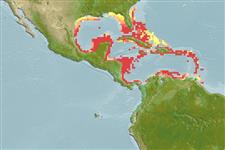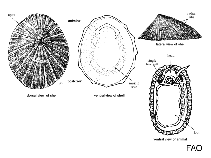Patelloida pustulata (Helbling, 1779)
Spotted limpet| Native range | All suitable habitat | Point map | Year 2050 |

|
| This map was computer-generated and has not yet been reviewed. |
| Patelloida pustulata AquaMaps Data sources: GBIF OBIS |
Hochladen Photos
Google Bild | No image available for this species;
drawing shows typical species in Lottiidae.
Google Bild | No image available for this species;
drawing shows typical species in Lottiidae.
Classification / Names Common names | Synonyms | CoL | ITIS | WoRMS
| Not assigned | Lottiidae
Environment: milieu / climate zone / depth range / distribution range Ökologie
; tiefenbereich 0 - 60 m (Ref. 83435). Tropical; 27°C - 28°C (Ref. 87155); 32°N - 9°N, 97°E - 0°W (Ref. 83435)
Verbreitung Länder | FAO Gebiete | Ecosystems | Vorkommen | Einführungen
Western Central Atlantic.
Length at first maturity / Size / Gewicht / Alter
Maturity: Lm ? range ? - ? cm Max length : 2.8 cm TL Männchen/unbestimmt; (Ref. 83435)
Maximum length is based on maximum reported size from Ref. 083435 Known from coral reefs, intertidal and offshore areas; on rocky substrates (Ref. 83934) and offshore banks (Ref. 109264).
Life cycle and mating behavior Geschlechtsreife | Fortpflanzung | Ablaichen | Eier | Fecundity | Larven
Members of the order Patellogastropoda are mostly gonochoric and broadcast spawners. Life cycle: Embryos develop into planktonic trocophore larvae and later into juvenile veligers before becoming fully grown adults.
Hauptreferenz
Referenzen | Koordinator | Partner
Kirkendale, L.A. and C.P. Meyer. 2004. (Ref. 7991)
IUCN Rote Liste Status (Ref. 130435)
CITES Status (Ref. 108899)
Not Evaluated
CMS (Ref. 116361)
Not Evaluated
Bedrohung für Menschen
Nutzung durch Menschen
| FishSource |
Tools
Mehr Information
Alter/Größe
Wachstum
Länge-Gewicht
Länge-Länge
Morphologie
Larven
Dichte
Wachstum
Länge-Gewicht
Länge-Länge
Morphologie
Larven
Dichte
Internet Quellen
BHL | BOLD Systems | CISTI | DiscoverLife | FAO(Publication : search) | Fishipedia | GenBank (Genom, nucleotide) | GloBI | Gomexsi | Google Books | Google Scholar | Google | PubMed | Tree of Life | Wikipedia (Gehe zu, Suchen) | Zoological Record
Estimates based on models
Preferred temperature
(Ref. 115969): 25.7 - 28, mean 27.4 (based on 114 cells).
Preiskategorie
(Ref. 80766):
Unknown.



